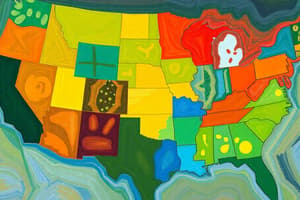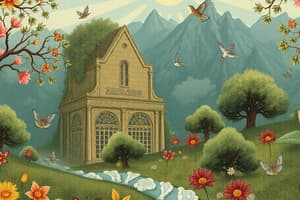Podcast
Questions and Answers
What is a biome?
What is a biome?
- A large, distinct aquatic region with similar climate, water, plants, and animals
- A small, distinct terrestrial region with similar climate, soil, plants, and animals
- A small, distinct aquatic region with similar climate, water, plants, and animals
- A large, relatively distinct terrestrial region with similar climate, soil, plants, and animals (correct)
Which of the following is a characteristic of the tundra biome?
Which of the following is a characteristic of the tundra biome?
- Treeless, with mosses, lichens, and grasses (correct)
- Warm, humid summers and mild winters
- Fertile, well-drained soil
- Tall, dense forests
What is the primary factor that determines the distribution of biomes?
What is the primary factor that determines the distribution of biomes?
- Temperature and precipitation (correct)
- Altitude
- Soil composition
- Biodiversity
Which of the following is a characteristic of the boreal forest biome?
Which of the following is a characteristic of the boreal forest biome?
What is the primary reason for the slow recovery of the tundra biome from disturbances?
What is the primary reason for the slow recovery of the tundra biome from disturbances?
Which of the following is a common animal species found in the tundra biome?
Which of the following is a common animal species found in the tundra biome?
Which of the following biomes experiences extremely cold and severe winters?
Which of the following biomes experiences extremely cold and severe winters?
What is a characteristic of the soil in the boreal forest?
What is a characteristic of the soil in the boreal forest?
Which of the following is a dominant tree species in the temperate rain forest?
Which of the following is a dominant tree species in the temperate rain forest?
What is a characteristic of the temperate rain forest?
What is a characteristic of the temperate rain forest?
Which of the following animals is found in the boreal forest?
Which of the following animals is found in the boreal forest?
What is a characteristic of the boreal forest?
What is a characteristic of the boreal forest?
Flashcards
Biome
Biome
A large, distinct terrestrial region with similar climate, soil, plants, and animals, regardless of location.
Tundra
Tundra
A treeless biome in the far north with cold winters, short summers, and low precipitation.
Boreal Forest (Taiga)
Boreal Forest (Taiga)
A region of coniferous forest in the Northern Hemisphere with long, cold winters and mild summers.
Temperate Rain Forest
Temperate Rain Forest
Signup and view all the flashcards
Tundra Flora and Fauna
Tundra Flora and Fauna
Signup and view all the flashcards
Boreal Forest Flora and Fauna
Boreal Forest Flora and Fauna
Signup and view all the flashcards
Temperate Rain Forest Flora
Temperate Rain Forest Flora
Signup and view all the flashcards
Permafrost
Permafrost
Signup and view all the flashcards
Tundra
Tundra
Signup and view all the flashcards
Boreal Forest
Boreal Forest
Signup and view all the flashcards
Temperate Rain Forest
Temperate Rain Forest
Signup and view all the flashcards
Climate factors influencing biome distribution
Climate factors influencing biome distribution
Signup and view all the flashcards
Study Notes
Biome
- A large, distinct terrestrial region with similar climate, soil, plants, and animals, regardless of location.
- Encompasses many interacting ecosystems.
- Considered the next level of ecological organization above community, ecosystem, and landscape.
- Temperature and precipitation have a significant effect on biome distribution.
Tundra
- A treeless biome in the far north with boggy plains covered by lichens and mosses.
- Harsh, cold winters and extremely short summers.
- Growing season is short, with long days.
- Little precipitation (10-25 cm/year), mostly falling during summer months.
- Soil is nutrient poor and has little detritus.
- Permafrost beneath the surface soil impedes drainage.
- Landscape features broad, shallow lakes and ponds, sluggish streams, and bogs.
- Recovers slowly from even small disturbances.
Tundra Flora and Fauna
- Supports relatively few species but in great numbers.
- Dominant plants: Mosses, lichens, grasses, and grasslike sedges.
- Tundra plants seldom grow taller than 30 cm (12 in).
- Year-round residents: Lemmings, voles, weasels, arctic foxes, snowshoe hares, ptarmigan, snowy owls, and musk oxen.
Boreal Forest (Taiga)
- A region of coniferous forest in the Northern Hemisphere, located just south of the tundra.
- Winters are extremely cold and severe, although not as harsh as those in the tundra.
- Receives little precipitation (50 cm/year).
- Soil is typically acidic and mineral poor, with a thick surface layer of partly decomposed pine and spruce needles.
- Permafrost deep under the surface.
- Features numerous ponds and lakes dug by ice sheets during the last ice age.
- World's top source of industrial wood and wood fiber.
Boreal Forest Flora and Fauna
- Dominant plants: Black and white spruces, balsam fir, eastern larch, and other conifers.
- Conifers have many drought-resistant adaptations, such as needle-like leaves.
- Large species: Caribou, which migrate from the tundra for winter; wolves; brown and black bears; and moose.
- Most boreal mammals are medium-sized to small, including rodents, rabbits, and smaller predators.
- Birds are abundant in the summer but migrate to warmer climates for winter.
- Insects are plentiful, but few amphibians and reptiles occur except in the southern boreal forest.
Temperate Rain Forest
- A coniferous biome with cool weather, dense fog, and high precipitation.
- Occurs on the northwest coast of North America, southeastern Australia, and in southern South America.
- Annual precipitation is high (> 127 cm/year), augmented by condensation of water from dense coastal fogs.
- Seasonal fluctuation is narrow; winters are mild, and summers are cool.
- Relatively nutrient-poor soil, though its organic content may be high.
- Cool temperatures slow the activity of bacterial and fungal decomposers.
- Rich wood producer, supplying lumber and pulpwood.
Temperate Rain Forest Flora
- Dominant plants: Large evergreen trees such as western hemlock, Douglas fir, western red cedar, Sitka spruce, and western arborvitae.
- Rich in epiphytes, mainly mosses, club mosses, lichens, and ferns, which also carpet the ground.
Studying That Suits You
Use AI to generate personalized quizzes and flashcards to suit your learning preferences.




